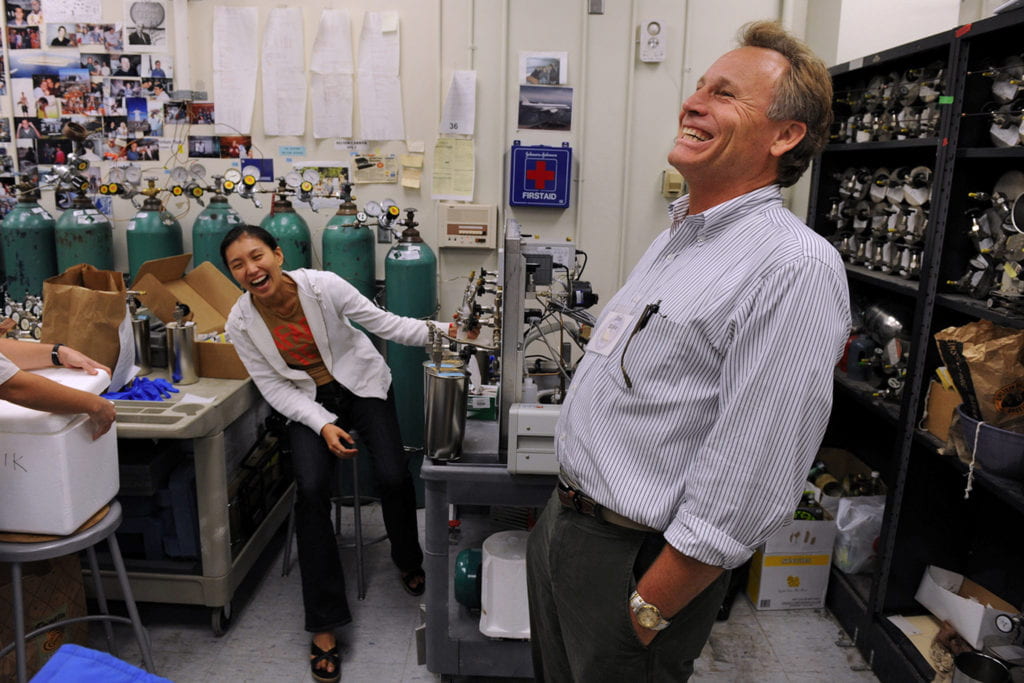Is oil spill also fouling the air?
UCI researchers find disturbing amounts of certain gases above massive Gulf slick. More study is needed.
Record levels of potentially harmful chemicals have been detected by UC Irvine researchers in the air around the BP oil spill in the Gulf of Mexico. While the findings are preliminary, they illustrate a critical need for further testing.
“There are lots of hydrocarbons rising from all this muck,” says Donald Blake, chemistry department chair. “What we don’t know is whether this air came from somewhere else or is bubbling up from below.”
He and Nobel laureate chemist F. Sherwood Rowland are poring over data collected during recent plane flights and boat trips through the spill area. Air samples from about 400 canisters are being scrutinized.
The concentrations of certain chemicals exceed any they’ve found before, Blake says, including over Mexico City, Oklahoma oil tank farms and other heavily polluted urban areas. “This is more alkyl nitrates than we’ve ever seen,” says the professor of chemistry and Earth system science. “These are much higher levels than in Los Angeles.”
The amounts detected, however, are lower than safety thresholds established by regulators.
The U.S. Environmental Protection Agency has been testing the air for different substances, namely smog and soot-related pollutants. Conditions have ranged from “good” to “unhealthy for sensitive groups,” according to its reports.
The Occupational Safety & Health Administration, which is overseeing worker safety in the spill area, also monitors air quality. “We have found no exposure levels to any chemicals that are of any concern,” says Jordan Barab, deputy assistant secretary of labor for OSHA.
The UCI team is examining evidence of so-called atmospheric gases rather than diesel soot particles or other pollutants linked to the burn-off of spilled oil. The alkyl nitrates, methane, and hexane and butane compounds they’ve identified could be from oil rising to the surface, the dispersant used to break it up or other unknown sources.
Blake and Rowland, Donald Bren Research Professor in chemistry and Earth system science, say they’re frustrated by insufficient funding and government coordination of air testing above the massive slick, particularly amid news reports about cleanup crews and oil workers feeling sick. Certain alkyl nitrates can irritate or burn skin and eyes, according to recent studies, and concentrated vapors can cause dizziness or suffocation.
While the amounts of individual gases might not reach official risk levels, the unknown effects of the combined swirl of chemicals are a concern. “Somebody should be tasked with a very thorough study of these gases,” says Blake. “There are millions of gallons of oil under the surface. What happens next month if a huge blob rises to the surface?”
The UCI researchers cobbled together limited university, state and federal funding for their initial work. In May, they loaded testing canisters onto a high-altitude plane but found surprisingly few chemicals.
The team then chartered the Eugenia, a fishing boat out of Houma, La., whose captain filled more canisters for them, making sure to do it away from the vessel’s engine. (He threw in a bottle of gunk-filled water for good measure; Blake says he may test the air in that as well.) This time, spikes of heavier gases hovering close to the water were detected.
In early June, the scientists contacted the EPA and the National Oceanic & Atmospheric Administration about their preliminary results. EPA officials have not responded, but NOAA followed up with a monitoring flight of its own over the area. Nearly 100 UCI canisters were tucked next to that plane’s radar system to harvest additional air samples.
The UCI chemists are now teasing out which of several hundred possible airborne pollutants are present above the oil spill and its miles-long plumes.
Rowland is particularly interested in a high methane reading near a finger of land along Louisiana’s Gulf Coast. Other chemicals detected include benzene, toluene and xylenes.
“There needs to be some government agency coordinating this effort,” says Blake. “Monitoring should be required for years.”

